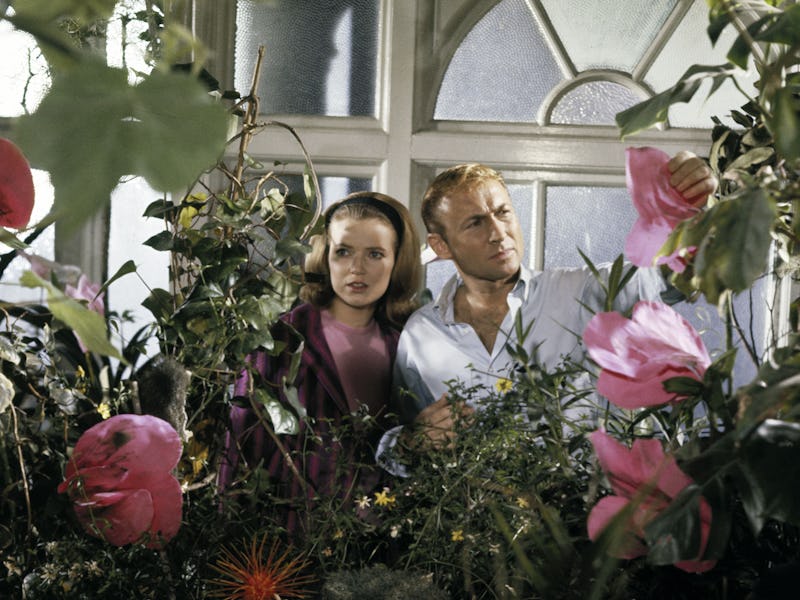A Forgotten Boris Karloff B-Movie Adapted Lovecraft With A Refreshing Trashiness
The Colour Out of Space was never this fun.

The impact of H.P. Lovecraft’s writing on cinematic horror is indelible. But only a handful of direct adaptations of the writer’s work come to mind. Lovecraft’s dense prose, his descriptions of gradual, incremental transformations and his first-person, sanity-losing perspectives — not to mention his “Great Old Ones,” eldritch monsters in the Cthululu mythos — have such a stark and lasting impact on the reader’s psyche that his voice pervaded through successive generations of writers and filmmakers, even if attempting to commit his voice to the screen takes much of the heft away from his "unimaginable" fears.
This is probably why Lovecraft’s relationship with film and TV lies more with reimaginings and homages: Hellraiser, The Mist, and Lovecraft Country all feel unique to their respective writer’s voice, born out of an intimate understanding of why Lovecraft’s horror scares us. (See also John Carpenter’s compromised but exhilarating In the Mouth of Madness.) Films like Re-Animator, From Beyond, and The Resurrected are more official, but they belong to a pulpy, surreal and more than a little goofy tradition of SFX-heavy B-movies that disappeared after the ‘80s. Recent indie projects like Colour Out of Space and Suitable Flesh feel indebted to in their attempts to bring back Lovecraft in the modern age.
Faithful, period-accurate adaptations have often faltered: an ambitious Guillermo Del Toro adaptation of At the Mountains of Madness has been laid to rest; a similarly tantalising ‘70s take on The Call of Cthulhu also fell apart; no further word on James Wan’s eldritch monster epic. Plenty of shorts and no-budget features have been made over the years, but few are worth writing home about — and only further stress that faithfully adapting Lovecraft is one of the trickiest endeavors genre filmmakers can attempt.
It’s probably why Die, Monster, Die!, which just turned 60 years old, feels so refreshingly modest and transparent. Long before Lovecraft adaptations received their “white whale” reputation, American International Pictures — an A-grade B-picture studio that Roger Corman called home in the ‘50s and ‘60s — produced a loose and hokey version of The Colour Out of Space for the teenage drive-in crowd, a demographic that AIP laid claim to as their speciality.
In Die, Monster, Die! (a delightfully blunt title in the imperative mood), an American comes to England — that’s old England, rather than the haunted New England of Lovecraft’s short story. The town name, Arkham, remains the same, and it’s where Steve Reinhart (Nick Adams) has come to meet his college sweetheart Susan Witley (Suzan Farmer). Before he reunites with his fiancée, he encounters a series of rude, aggressive locals trying to ward him off — not just pub drinkers who curse the name Witley or a shopkeeper who refuses to rent him a bike, but even the elder Witley himself, the wheelchair-bound Nahum (Boris Karloff) who insists that Steve leaves his daughter alone.
Susan is thrilled to see him, but strangeness and sickness hangs over the manor: on top of her father’s disability and the extreme age of their manservant Merwyn (Terence De Marney), the maid Helga recently fell ill and disappeared, and Susan’s mother Letitia (Freda Jackson) is bedbound with veils concealing her face. Nahum is clearly hiding something, and the fact that his father Corbin went insane and died in mysterious circumstances has something to do with it.
Boris Karloff strikes a sinister figure in a trashy B-movie.
Already we have departed significantly from Lovecraft’s story, which is written from a first-person perspective of a visitor to Arkham who is scared by the local story of a family succumbing to the malign alien influence of a meteorite that cannot be classified by teams of scientists. There’s a clinical, morbidly curious tone to Lovecraft’s story that’s replaced here with third-rate mystery plotting. It merges B-movie shocks with Lovecraft and Poe as Steve discovers the supercharged plant and animal life that Nahum became obsessed with, despite severe radioactive repercussions.
Die, Monster, Die! comes with stock, modest thrills — cloaked strangers watching from a dark window, strange glowing chambers, weird, glowing creatures, and finally, an irradiated, superpowered zombie. Many AIP horror films featured bright, eye-catching colors, and it’s fitting that this Colour Out of Space film is packed with greens, purples, and red lighting that signal a dangerous unknown quality around the haunted English estate (the film was shot in Shepperton Studios in Surrey, England). Decades before more serious and ambitious Lovecraft adaptations would struggle to articulate their visions and receive studio backing, there’s a mercenary quality to Die, Monster, Die! — it takes a property, steals the most outrageous elements, packages it for teenagers and moves on — that avoids the pretension or unwieldy ambitions that would go on to plague filmmakers who wanted to stage a faithful Lovecraft film.
Wrapping up in under 80 minutes, Die, Monster, Die! sidesteps the problems of adapting atmospheric and literary horror into mainstream cinema by shifting into a low-rent, solely commercial gear that, in its more unhinged and aggressive moments, is entertaining in its lack of careful, tasteful style and tone. It’s the lack of seriousness to Die, Monster, Die!, with its hammy performances but artificial, attractive production design and effects, that distinguishes it as an accessible gateway into Lovecraft’s chasms of cosmic dread; an exercise in making something challenging digestible, interested only in the source material as a jumping-off point for lurid and easy kicks. Die, Monster, Die! shrugs off the seismic reputation of Lovecraft with a refreshing breeziness.